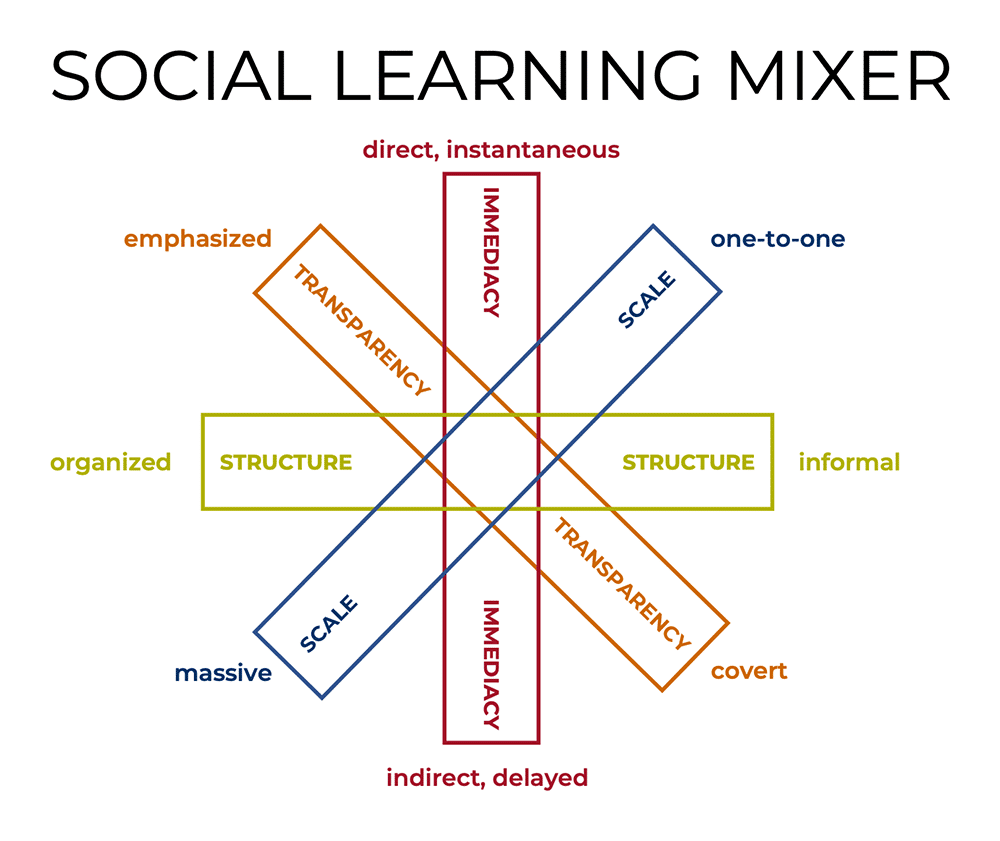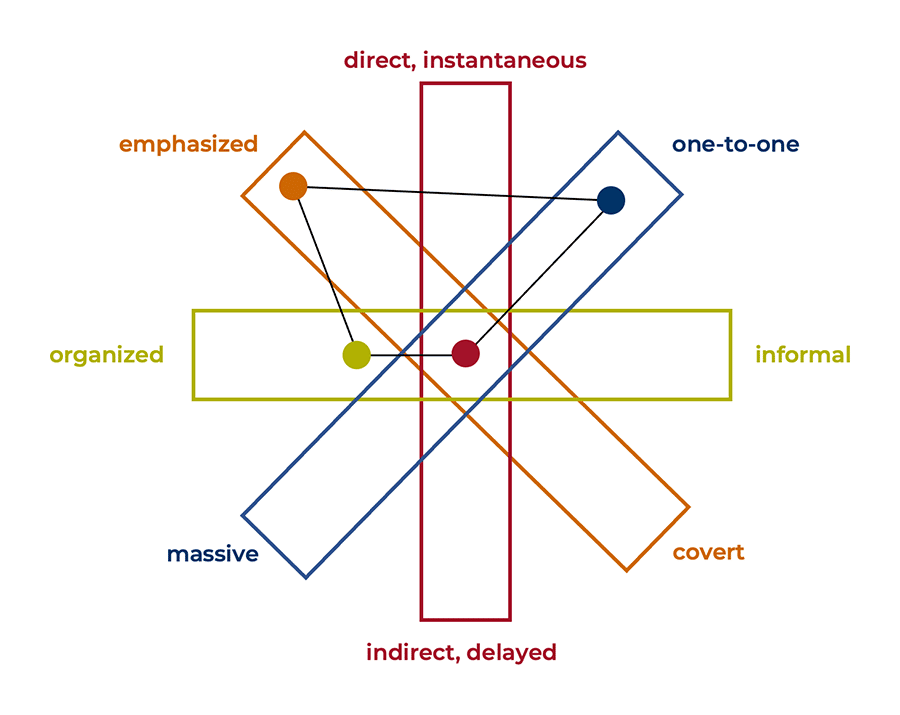Social learning is natural and highly effective. The COVID-19 pandemic challenged many traditional approaches, so now more than ever people are craving the return of social learning. And that represents a huge opportunity for learning businesses.
In this seventh episode in our tool talk series, we dive deeper into the topic of social learning: why it’s important for learning businesses, four dimensions that define it, and how to design it strategically using the Social Learning Mixer.
To tune in, listen below. To make sure you catch all future episodes, be sure to subscribe via RSS, Apple Podcasts, Spotify, Stitcher Radio, iHeartRadio, PodBean, or any podcatcher service you may use (e.g., Overcast). And, if you like the podcast, be sure to give it a tweet.
Listen to the Show
Access the Transcript
Download a PDF transcript of this episode’s audio.
Read the Show Notes
[00:00] – Intro
Why Is Social Learning Important?
[01:30] – The simplest explanation of why social learning is important is because it’s effective. Humans are social beings, and we learn by watching and imitating others. Babies learning to walk and talk is a classic example of this.
That same observation-plus-trial approach serves us humans well into adulthood. It’s at the root of job shadowing and other on-the-job training. Social learning is effective and natural for humans.
And learning businesses are usually well positioned to develop and deliver social learning. Learning businesses are often structured around serving a profession, industry, or field, and so they often interact with practitioners of varying skill levels and experience levels and different areas of emphasis. By bringing those practitioners together, they can learn from one another.
Social learning covers the transfer of knowledge, ideas, and skills that happens when humans interact with one another.
The interaction piece of social learning is fundamental, and that social interaction was curtailed and changed by the COVID-19 pandemic.
Social learning is arguably more attractive and appealing as the pandemic lessens and it becomes safer to gather together physically. There’s pent-up demand for social learning, and there’s a business opportunity for learning businesses that figure out how to satisfy that demand.
Social learning doesn’t have to happen in person. The pent-up demand may be focused on in-person social learning, but the pandemic also showed us that we can gather, connect, and learn together in online spaces as well as physical spaces.
Social learning is effective, natural, and newly attractive and relevant in the current lessening-pandemic moment. That sums up why learning businesses should think strategically about what they do with social learning.
Jeff Cobb
What Is the Social Learning Mixer?
[04:52] – The Social Learning Mixer looks at four key dimensions that define social learning.
- Immediacy
- Structure
- Scale
- Transparency
1. Immediacy
The continuum for immediacy ranges from direct and instant involvement of learners to delayed and indirect exchanges.
The direct and instant end covers informal face-to-face conversations that might happen before a place-based workshop as well as group work a facilitator has learners do in small groups during that workshop.
The delayed and indirect end covers discussion forums. Someone posting in an online community looking for recommendations on how to embed design thinking in their learning business, for example, is looking for general help—they don’t have a specific recipient in mind. And it’s possible that someone six months from now who’s interested in design thinking will come across the thread and find valuable help.
2. Structure
Structure can be more or less apparent in social learning—that is, social learning can be more or less formal. As this dimension makes clear, social learning is not necessarily informal learning. It may be, but the two are not coterminous.
On the less structured end, a learning business might match a mentor to a mentee, and that’s the extent of the design involved.
Or a learning business could take a more structured approach to social learning by providing mentors and mentees with activities and questions to work through according to a recommended timeline.
3. Scale
Social learning can be small-scale or massive. At one extreme, social learning need only involve two people—the mentor and mentee example is a simple two-person social learning approach. At the other end, social learning can involve thousands, even millions of learners.
When Stephen Downes and George Siemens offered what was arguably the first massive open online course (MOOC) in 2008—called “Connectivism and Connective Knowledge”—over 2,200 learners signed on. Massive social learning took place in the context of that MOOC.
As another example, Coursera’s “Learning How to Learn” MOOC with Dr. Barbara Oakely has had more 3.3 million enrollments so far—and the course is still running and welcoming more learners.
See our related episode “Learning How to Learn with Dr. Barbara Oakley.”
[08:14] – Most learning businesses probably won’t aim for such a large scale with their social learning, but it is interesting to think about scaling social learning offerings. A two-person mentorship experience can be scaled. We know organizations doing that by leveraging technology and algorithms to match partners and to provide structure.
When Dr. Veronica Diaz was on the show, she talked about how EDUCAUSE is trying to scale to mentoring.
4. Transparency
Transparency has to do with how aware the learners are about the social aspect of the learning experience. Transparency relates to the first two dimensions: immediacy and structure.
The more immediate and the more structured the social learning, the more likely learners are to see how the learning is social. But we include transparency as a separate dimension because, even in the case of immediate and structured social learning, designers get to decide whether to forefront what they’re doing in a particular learning experience to support social learning or whether to bake social learning in without calling attention to it.
One facilitator might simply tell learners to look at each others’ projects and provide a comment. Another facilitator might tell the learners that giving and getting feedback is an important part of learning and that they can learn not only from the comments they get on their project and the comments they give but also from comments that their peers provide on other learners’ projects. That second facilitator is priming learners for social learning by calling attention to it.
One of the biggest issues with designing social learning is that, like that first facilitator, we may underthink it. We may underthink it because we know social learning is how so many skills and so much knowledge is shared, and so we assume that all we have to do is provide a way for two or more learners to connect—put them in the same room or add them to the same online community—and then, voilà, social learning happens.
We see that kind of thing all the time, I think, in conference sessions, where people are just told to talk among themselves and something magic is going to come out of it. But often you do need that bit of scaffolding and structure around it. You need a social learning object that’s meaningful to them to interact around.
Jeff Cobb
Social learning takes planning, even if you are going to make it completely transparent to the learner. You need to think through what you’re trying to achieve and how you’re setting learners up for success.
Going back to the structure dimension, structure runs from less structure to more structure—and there’s a big difference between no structure and even just a bit of structure and scaffolding to help social interactions contribute to learning transfer and deeper understanding of concepts and ideas.
[U]nderthinking social learning tends to lead to learning businesses and learning designers focusing on social learning tools rather than social learning philosophy. So we tend to worry about which tools to use for social learning. We worry about picking the right one. And the assumption that’s built into that is that if you have the right tool or tools, social learning will happen naturally. And that’s simply just not usually the case.
Celisa Steele
How Do You Use the Social Learning Mixer?
[12:17] – Let’s turn to how to design effective social learning, given that simply having community software or other options in place usually isn’t enough. Awareness of the four dimensions is key.
Just knowing to consider immediacy, structure, scale, and transparency is an important first step in helping you design effective social learning. Once you know about the four dimensions, then you and your team can make conscious and strategic decisions about each dimension, given the audience and goals for a particular learning experience.
Each dimension is a spectrum.
Immediacy ranges from direct and instantaneous to indirect and delayed.
At one end, you have in-person, real-time exchanges with others. At the other end, you have exchanges that may happen via online discussion boards, meaning a response might take days or weeks. A podcast, like the Leading Learning Podcast, may fall at the more delayed and indirect end of immediacy.
Structure ranges from informal to highly organized.
Informal might involve building in time for peer networking during a learning experience but largely leaving what peers talk about up to them. On the highly organized end, you might do work up front to identify which peers would benefit from talking with which others and create custom discussion groups along with suggested questions or topics for them to cover.
Scale ranges from one-on-one social exchanges to massive, large-group interactions, like the MOOC we mentioned.
Transparency ranges from covert to overt.
In a covert case, the social learning aspect of an experience is there, but it’s not emphasized. No one calls the learners’ attention to it.
In an overt case, the social learning is emphasized—maybe it’s even a key selling point for the learning experience.
Those are the endpoints on the dimensions, but, of course, you can land anywhere along the spectrum for each dimension. So each dimension is a slider that you can adjust to yield the desired mix.
[15:06] – This is where our tool for this episode comes in: the Social Learning Mixer.

The mixer looks like an asterisk made up of four lines. Each line represents one of the four dimensions. Place a dot along each line (dimension) to indicate where the learning product falls. Plotting these points gives you a visual that represents the social learning mix for a product or product line.
This tool, like many of the others we’ve discussed, is a way to start meaningful conversations about social learning and to provide a framework so your team is thinking about common choices in social learning design.
Beyond starting conversation, you can also use the Social Learning Mixer to assess your existing offerings. You can plot points to give you a visual representation of the social learning mix in each of your products.
Once you’ve inventoried your use of social learning in products, look for patterns.
If all your social learning is very loosely structured or done on a large scale, that may suggest an opportunity to experiment at other points on those dimensions.
If you see no patterns when you’ve done your inventory, that might suggest that your organization needs to be more holistically aware of social learning so that what’s working for one product could be applied to another product.
Are there products that you can’t adequately inventory or create a visual for because you don’t know enough about them? This could be the case for some of your face-to-face concurrent sessions at a conference, for example, where maybe all you do is pick a presenter and a topic based on a short session description, and you don’t really know what happens in the room.
The Social Learning Mixer can be a good tool to make your presenters aware of as well, so they’re thinking about social learning when it comes to planning their conference sessions.
As you inventory what you’re doing, you can also assess the effectiveness of your products in terms of social learning. For each product, what is the learning outcome you’re trying to achieve? An awareness of the context can help you assess whether the current mix of immediacy, structure, scale, and transparency is appropriate.
There are no value judgments, no across-the-board right or wrong approaches. You have to think through what each product is trying to do. How would you rate the effectiveness of your educational products’ use of social learning?
In offering these four dimensions, we offer a way to look at social learning in its many incarnations.
But no particular point along any of the four dimensions is inherently better than any other. It’s not necessarily better for social learning to happen on a large scale or to be more immediate. It’s not de facto better for social learning to be less structured or more transparent. It all depends on what you’re trying to achieve. It depends on your goals, and it depends on what your audience needs and wants and is capable of responding to.
Celisa Steele
You can use the Social Learning Mixer to assess existing products, but you can also use it when designing new products or revising existing products and trying to identify the ideal mix of each dimension.
To help you get better at determining what type of social learning will work best for what goals and which audiences, take time to experience social learning as a learner. What social learning are you experiencing beyond what your organization offers?
Take time to try out other social learning, both offerings that are similar to what your organization is doing (or trying to do) and also different from what you’re doing. If you’re a thoughtful social learner, you’ll pick up ideas and tools that may apply to what your organization offers—or will offer in the future.
Note that all of the activities we’ve mentioned—inventorying what you’re currently doing, assessing its effectiveness, trying out other social learning—will help your learning business get better at designing and delivering it effectively.
[21:26] – Wrap-up



 Identifying Ideal Customers with Pamela Slim
Identifying Ideal Customers with Pamela Slim
Leave a Reply